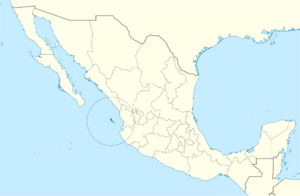Tres Marias hummingbird facts for kids
Quick facts for kids Tres Marias hummingbird |
|
|---|---|
| Conservation status | |
| Scientific classification | |
| Genus: |
Cynanthus
|
| Species: |
lawrencei
|
 |
|
The Tres Marías hummingbird (Cynanthus lawrencei) is a small, colorful bird. It is a type of hummingbird that lives only on the Islas Marías islands. These islands are off the west coast of Mexico. This hummingbird is considered a Near Threatened species. This means it could become endangered if we don't protect it. It used to be thought of as a type of broad-billed hummingbird. But now, scientists know it's its own special species.
Contents
About the Tres Marías Hummingbird
How Scientists Classify It
For a long time, people thought the Tres Marías hummingbird was just a type of broad-billed hummingbird. Scientists call these "subspecies." But new studies in 2014 and 2017 showed something different.
By 2022, big groups of bird experts agreed. Organizations like the American Ornithological Society and the International Ornithological Committee now say it's a unique species. This hummingbird is also "monotypic." This means it's the only species in its group, with no other subspecies.
What It Looks Like
The Tres Marías hummingbird has a special bill. It's reddish with a black tip. Both male and female birds have shiny, metallic bronze-green feathers on their upper bodies. These feathers are a bit duller on their heads.
Male hummingbirds are very colorful. Their throats can be turquoise-green or emerald green. They have a greeny-bronze chest and a dark green belly. Their tail feathers are a glossy blue-black color.
Female hummingbirds are a bit less bright. Their upper parts are duller than the males'. They have gray feathers on their undersides. The base of their tail is bronze-green. The rest of their tail is blue-black or greenish-black. The two outermost tail feathers have white tips.
Where It Lives
This special hummingbird lives only on two islands. These are María Madre and María Cleofás. They are part of the Islas Marías group. These islands are located off the coast of Nayarit, Mexico. Scientists haven't fully described the exact places they like to live on the islands.
Hummingbird Behavior
How It Moves Around
The Tres Marías hummingbird usually stays in one place. Scientists call this "sedentary." However, some of these birds have been found on the mainland of Nayarit. This suggests they might sometimes fly across the water.
What It Eats
Scientists haven't studied the exact diet of the Tres Marías hummingbird. But like most hummingbirds, it probably eats nectar from many different flowers. Nectar is a sweet liquid that gives them energy. They also eat small arthropods, like tiny insects or spiders. These give them important protein.
Reproduction and Life Cycle
Not much is known about how the Tres Marías hummingbird breeds. Scientists haven't published specific details about their nesting or how they raise their young. We can guess it's similar to other hummingbirds.
What Its Calls Sound Like
The sounds of the Tres Marías hummingbird haven't been described separately. But we know what the broad-billed hummingbird sounds like. Males of that species sing a song. It starts with a short "chip" sound. Then, it has a series of similar notes. These notes can range from low to high in sound.
Protecting the Tres Marías Hummingbird
The IUCN (International Union for Conservation of Nature) has looked at this hummingbird. They have listed it as "Near Threatened." This means it's not endangered yet, but it could be in the future.
This hummingbird lives in a very small area. Scientists believe there are fewer than 2,500 adult birds. However, the number of birds seems to be staying steady.
There are some things that could harm these birds. These include losing their habitat due to cities growing or farming. Cutting down trees for wood is also a threat. Also, new animals brought to the islands, like cats or rats, could hunt them. Protecting their island home is very important for their future.


